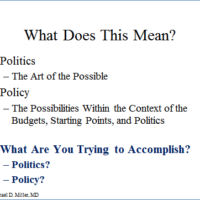An article in the July/August Health Affairs about Massachusetts health plans implementing Pay-for-Performance (P4P) incentives for physicians raised more questions than it answered.
The study found that P4P programs from 5 private sector payers “wasn’t associated with greater improvement in quality” compared to the overall upward trend in the factors measured. But the study didn’t address some overarching questions and basic realities about P4P, such as:
- How the payers P4P incentives to the physician groups was actually translated into incentives for the individual physicians – or smaller groups of physicians inside the larger groups?
- How the P4P incentives compared to the other financial incentives the physicians are facing? For example, seeing more patients or doing more procedures could increase their income more than meeting the P4P standards. (The Health Affairs article states that P4P incentives for Massachusetts physician groups averaged 2.2% of their income.)
- The quality measures used in the study were all performance based, rather than actual outcomes, e.g. cholesterol screening rates rather than patients’ actual cholesterol levels, HbA1C screening rates in diabetics rather than their actual HbA1C levels, or asthma medication use for children ages 5-17, rather than ER visits or hospitalizations for these same children. What impact does that has on physicians’ behavior, and the value of changing their actions to meet these process standards? Would physicians be more responsive to incentives tied to clinical outcomes?
Making Incentive Programs Successful:
While the study concluded that the P4P incentives program instituted in 2002 may not have produced dramatic changes in the HEDIS process measures, that does not mean they were ineffective or that P4P is not a useful tool.
First, while collecting process measures data is easier, since clinical outcomes are what patients (and their physicians) should really care about, shouldn’t P4P incentives be based upon actual clinical outcomes? Process measures are easier to monitor by using billing data, but as the prevalence of quality electronic medical records systems grows, collecting and analyzing data about clinical outcomes will become much easier. In addition, measuring a small set of any factors – process or outcome – presents the pitfall of driving physicians to focus on those diseases and measures to the exclusion of other important things. For example, in the Health Affairs study, there are a number of preventive services in the process measures, but what about flu vaccinations, colonoscopies or smoking cessation? This “managing what is being measured” behavior is why the number of factors used for P4P incentives should be as broad as possible. (But this does not mean that they all have to be measured at every interval, or for every compensation period.)
Second, as any psychologist (or parent) will attest, the time between the actions and the reward (or penalty) is very important for changing behaviors. The Health Affairs article indicates that the bonuses are paid to the physicians groups annually. Having the incentives paid annually, (or even quarterly), would be unlikely to provide adequate feedback to physicians to prompt them to change their behaviors. An alternative blended methodology would be to provide physicians feedback on their actual performance against many of the possible measures on a weekly or bi-weekly basis, while making the P4P payments on a monthly or quarterly basis.
Third, many large companies structure their bonuses for their senior managers around a minimum of 20% of compensation. If incentives for P4P programs only represent a small percentage of physicians’ income, then it would be unlikely to change their behaviors – particularly if they can make up for any lost income by increasing volume. However, if physicians are being paid a fixed (capitated) amount per month to provide a certain set of services to a patient group – either primary or specialty care – then the volume part of the equation disappears, and P4P programs could be much more effective, even at a lower fraction of their potential income.
And lastly, and most simply, the insurers would not be spending time and money developing and implementing these programs if they didn’t think they provided some benefit – even if it is only financial – so they must be getting some benefits, or at least learning some things to make these programs beneficial in the future.
Conclusions:
18 years ago I wrote a book chapter that focused on structuring incentives for physicians. Since then it has been hard to move payers and clinicians toward using more focused financial incentive systems. But the P4P concepts are important, and to be successful they need to be implemented in a way that works for payers, physicians, and patients. Unless these and other stakeholder groups buy-in to the purpose and practice of such incentives systems, they are unlikely to have the desired effects. And the result will be more of the same – rising costs, variable quality, and limited access for many patients.



[…] Health Policy and Communications Blog’s Michael Miller discusses a recent Health Affairs article (here) on Massachusetts’ efforts to implement a pay-for-performance program, saying that the study “raised more questions than it answered.” […]